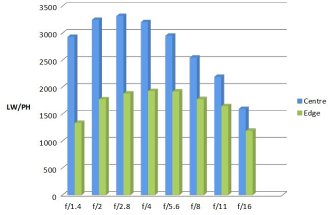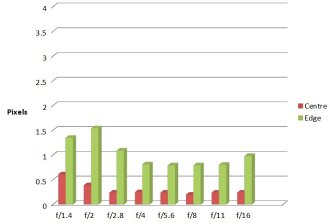Leica DG Summilux 12mm f/1.4 ASPH Review
Panasonic Leica DG Summilux 12mm f/1.4 Asph. Performance
Sharpness is clearly aimed at spectacular results in the centre of the frame, at the expense of the edges to some degree. At the centre, sharpness is outstanding from open aperture right through to f/5.6, which is a superb result and explains the impressive look of the images on screen.
The edges are not quite to the same high standard, but to be fair results are still very good from f2 through to f8, dropping to good at f/11. At f1.4 and f/16 sharpness is not really there and results can only be described as fair. However, many excellent lenses deliver the goods with “very good” levels of sharpness and the bonus here is that the centre is so dazzling.
How to read our charts
The blue column represents readings from the centre of the picture frame at the various apertures and the green is from the edges.The scale on the left side is an indication of actual image resolution as LW/PH and is described in detail above. The taller the column, the better the lens performance.
For this review, the lens was tested on a Panasonic Lumix GX80 using Imatest.
Distortion is almost zero, showing a very modest -0.38% of barrelling. CA (chromatic aberration) is also very low both at the centre and the edges of the field. Colour fringing will not be a problem.
How to read our charts
Chromatic aberration is the lens' inability to focus on the sensor or film all colours of visible light at the same point. Severe chromatic aberration gives a noticeable fringing or a halo effect around sharp edges within the picture. It can be cured in software.Apochromatic lenses have special lens elements (aspheric, extra-low dispersion etc) to minimize the problem, hence they usually cost more.
For this review, the lens was tested on a Panasonic Lumix GX80 using Imatest.
From the first moment that the images appear on the monitor screen it is obvious that this is a lens that produces very impressive results. Images are crisp and clean and visually very satisfying. Resistance to flare is excellent, particularly useful in a wide angle lens where the lens hood cannot be too intrusive because of the wide angle of view.
Overall, a superb result from a lens with very desirable properties.
Value For Money
The Panasonic Leica DG Summilux 12mm f/1.4 Asph lens is priced at £1199. There is nothing else this wide or fast for the MFT system. The nearest equivalents are the Olympus M.Zuiko 12mm f/2 Digital ED (£549) and two manual focus Samyang lenses. The Samyang 12mm f/2 NCS CS lens is £249 and the 12mm T2.2 Video lens is £329.
To achieve the same angle of view with an f/1.4 aperture we need to look at the Fujifilm Fujinon XF 16mm f/1.4 at £699, the Canon EF 24mm f/1.4 L II USM at £1099 and the Nikon 24mm f/1.4 G AF-S ED at £1572.
Against this backdrop, the new Panasonic Leica lens looks to be good value at its quality level, although it is undeniably a substantial investment. For more options have a look at the Top 7 Best Panasonic lenses, Top 5 Best Olympus Micro Four Thirds lenses, or Top 15 Wide-angle Lenses.
Add your message
Please login here or if you've not registered, you can register here. Registering is safe, quick and free.
photodo Stats
428 MTF tests
74 in-depth photodo reviews
100+ users join each day
Help the lens community by reviewing or rating a lens today via our lens search
Latest Lens Reviews
- Chinon 28mm f/2.8 Vintage Lens Review
- Canon EF 70-200mm f/4L IS II USM Lens Review
- Samyang AF 85mm f/1.4 EF Review
- Sigma 70mm f/2.8 DG Macro Art Review
- Samyang AF 24mm f/2.8 FE Review
- Meike 50mm f/1.7 Review
- Tamron 70-210mm f/4 Di VC USD Review
- Lensbaby Burnside 35mm f/2.8 Review
- Asahi Super Takumar 50mm f/1.4 Review
- Asahi Super-Multi-Coated Takumar 135mm f/3.5 Review


